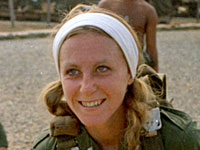 She Captured Vietnam
She Captured Vietnam
by Susan Mansfield
In 1966, at the height of the Vietnam War, a 21-year-old French girl bought a one-way ticket to Saigon. Taking little but her cameras and her bikini, Catherine Leroy went on to become one of the war’s most celebrated photographers.
A petite, stylishly dressed French woman, she had courage and determination that took her time and again to the front lines. Within a year she was winning awards, and her photographs were gracing the front pages of some of America’s most prestigious magazines.
Her recent death in Santa Monica from cancer at the age of 60 sparked a series of tributes. “She was tiny and totally fearless,” said the Washington Post journalist Jonathan Randal. “Like many young war photographers, she was probably braver than she was talented in the beginning. But she went on to become a very fine photographer.”
She was, in her own words, “absolutely obsessed” with becoming a photojournalist. As a convent schoolgirl in France she had pored over the pages of magazines such as Paris Match and dreamed of being the one behind the lens. She regularly sneaked away from school to listen to jazz in smoky bars, and at 18, she learned to parachute jump with her boyfriend…
She got her big break thanks to a mixture of determination and good luck. On the plane to Saigon from Laos, she met a friend of Charles Bonnay, a Life magazine photographer. Arriving in Saigon she presented herself to Horst Faas, of Associated Press, who told her to go do some work – which she did. She fearlessly found her way to the front lines, kitted out with the smallest pair of jungle boots she could find – still far too big – and captured some of the war’s most iconic images. One of the most famous, a picture of a soldier hunched over the body of a wounded comrade, was taken as she lay on her stomach in a paddy field, dodging bullets.
In 1967 she was the only accredited journalist to participate in a combat parachute jump with the 173rd Airborne in Operation Junction City, taking pictures from the plane before she jumped. Allegedly, her press privileges were temporarily suspended a few months later, when she badmouthed a US officer who would not let her take part in a second jump.
Later that year, she was injured by shrapnel, which broke her jaw. Her camera, she later said, saved her life by taking the worst of the blast. Six weeks later she was back in the field.
In 1968, during the Tet Offensive, she was captured by the North Vietnamese Army, and managed not only to talk her way out but also to photograph the soldiers in action – images which were subsequently used on the cover of Life magazine.
In a newspaper interview in 2005, she said: “War is nothing like its Hollywood portrayals, and it’s a terrible place to take photographs. The light is usually wrong. It’s dark, or it’s raining, or you’re in no position to shoot a picture.
“In Vietnam, most of the time it was extremely boring. Exhausting and boring. You walked for miles through rice paddies or jungle – walking, crawling, in the most unbearable circumstances. And nothing was happening. And then suddenly all hell would break loose.
“I think we were all looking to show what the war did to people, on both sides. Yes, we were very subjective. I don’t think, in a situation like that, you can be anything but subjective.”
Later she moved to the US, where she took all kinds of photographs, including celebrity portraits and fashion shoots, but war zones remained her passion, and she travelled to photograph conflicts in Somalia, Afghanistan, Iraq, Iran, Libya and Northern Ireland. She co-authored a book about the siege of West Beirut.
Her three years in Vietnam would remain the defining experience of her life. It was a war in which photography would play, perhaps, its most important role. Photographers had unprecedented access to the front lines, and sufficient technology to send their images home quickly. The immediacy of their work brought the reality of the conflict into the homes of ordinary people.
In 1972, she shot and directed Operation Last Patrol, a film about Ron Kovic, the anti-war Vietnam veteran whose story would form the basis of the Oscar-winning Tom Cruise movie Born on the Fourth of July. Last year she compiled and edited Under Fire, a book of Vietnam photographs and essays, and was instrumental in organising an outdoor exhibition of large-format Vietnam war photographs in Washington DC.
In recent years, she had retired from photography to devote her time to a business selling vintage haute couture in Los Angeles. She is remembered as a petite, stylish figure with a heavy French accent, whose immaculate appearance belied the fact that she had once dodged bullets in the paddy fields of Vietnam.
ATTENTION READERS
We See The World From All Sides and Want YOU To Be Fully Informed
In fact, intentional disinformation is a disgraceful scourge in media today. So to assuage any possible errant incorrect information posted herein, we strongly encourage you to seek corroboration from other non-VT sources before forming an educated opinion.
About VT - Policies & Disclosures - Comment Policy



